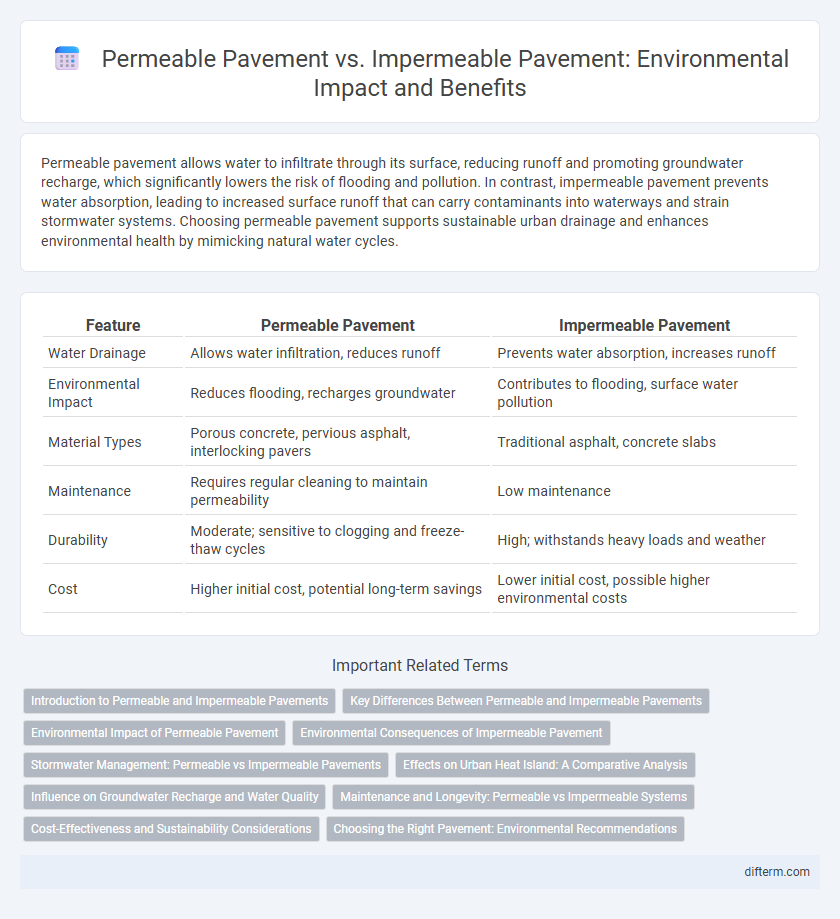Permeable pavement allows water to infiltrate through its surface, reducing runoff and promoting groundwater recharge, which significantly lowers the risk of flooding and pollution. In contrast, impermeable pavement prevents water absorption, leading to increased surface runoff that can carry contaminants into waterways and strain stormwater systems. Choosing permeable pavement supports sustainable urban drainage and enhances environmental health by mimicking natural water cycles.
Table of Comparison
| Feature | Permeable Pavement | Impermeable Pavement |
|---|---|---|
| Water Drainage | Allows water infiltration, reduces runoff | Prevents water absorption, increases runoff |
| Environmental Impact | Reduces flooding, recharges groundwater | Contributes to flooding, surface water pollution |
| Material Types | Porous concrete, pervious asphalt, interlocking pavers | Traditional asphalt, concrete slabs |
| Maintenance | Requires regular cleaning to maintain permeability | Low maintenance |
| Durability | Moderate; sensitive to clogging and freeze-thaw cycles | High; withstands heavy loads and weather |
| Cost | Higher initial cost, potential long-term savings | Lower initial cost, possible higher environmental costs |
Introduction to Permeable and Impermeable Pavements
Permeable pavements are designed to allow water to infiltrate through their surface, reducing runoff and promoting groundwater recharge, which mitigates urban flooding and decreases pollution in stormwater. Impermeable pavements, such as traditional asphalt and concrete, create a solid, non-porous surface that prevents water absorption, leading to increased surface runoff and higher risks of erosion and water contamination. Understanding the functional differences between permeable and impermeable pavements is crucial for sustainable urban design and effective stormwater management.
Key Differences Between Permeable and Impermeable Pavements
Permeable pavement allows water to infiltrate through its surface, reducing stormwater runoff and promoting groundwater recharge, whereas impermeable pavement prevents water absorption, leading to increased surface runoff and potential flooding. The materials used in permeable pavements, such as porous asphalt and pervious concrete, have interconnected voids to facilitate drainage, while impermeable pavements like traditional asphalt and concrete create a solid, non-porous barrier. Maintenance requirements differ significantly, with permeable pavements needing periodic cleaning to prevent clogging, unlike impermeable surfaces which typically require less frequent upkeep but contribute to urban heat island effects.
Environmental Impact of Permeable Pavement
Permeable pavement significantly reduces stormwater runoff by allowing water to infiltrate through the surface, decreasing the risk of flooding and erosion. It enhances groundwater recharge, filters pollutants, and mitigates urban heat island effects by promoting natural cooling. This sustainable infrastructure supports improved water quality and biodiversity, making it a crucial element in environmentally responsible urban planning.
Environmental Consequences of Impermeable Pavement
Impermable pavement significantly increases stormwater runoff, leading to higher risks of flooding and erosion while preventing natural groundwater recharge. It contributes to urban heat islands by absorbing and retaining heat, exacerbating local temperature rises. The accumulation of pollutants on impermeable surfaces often results in water contamination when runoff enters waterways untreated.
Stormwater Management: Permeable vs Impermeable Pavements
Permeable pavement significantly enhances stormwater management by allowing rainwater to infiltrate through the surface, reducing runoff and decreasing the risk of flooding and erosion. In contrast, impermeable pavement prevents water absorption, leading to increased surface runoff that can overwhelm drainage systems and contribute to water pollution. Utilizing permeable pavement supports groundwater recharge and mitigates stormwater impacts on urban environments.
Effects on Urban Heat Island: A Comparative Analysis
Permeable pavement reduces urban heat island effects by allowing water infiltration and enhancing evaporative cooling, which lowers surface and ambient temperatures compared to impermeable pavement that traps heat and increases thermal retention. Studies indicate that areas with permeable surfaces can experience temperature reductions of up to 2-5degC, directly mitigating urban heat stress. These temperature differences significantly impact energy consumption for cooling and improve urban microclimates, making permeable pavement a sustainable choice in urban planning.
Influence on Groundwater Recharge and Water Quality
Permeable pavement significantly enhances groundwater recharge by allowing rainwater to infiltrate through its porous surface, reducing surface runoff and promoting aquifer replenishment. In contrast, impermeable pavement prevents infiltration, leading to increased surface runoff that carries pollutants into storm drains, negatively impacting water quality. Implementing permeable pavement systems mitigates urban flooding and improves water quality by filtering contaminants before they reach groundwater sources.
Maintenance and Longevity: Permeable vs Impermeable Systems
Permeable pavement requires regular maintenance such as vacuum sweeping and occasional surface infiltration testing to prevent clogging and maintain permeability, often resulting in longer functional lifespan under proper care. Impermeable pavement demands less frequent surface maintenance but is prone to faster deterioration from water pooling, leading to increased repair needs and reduced longevity. Effective management of permeable systems enhances durability and environmental benefits, while impermeable pavements typically have shorter service life due to water-related damage.
Cost-Effectiveness and Sustainability Considerations
Permeable pavement offers cost-effective stormwater management by reducing the need for extensive drainage systems and mitigating flood-related damages, which lowers long-term maintenance expenses. Its sustainable benefits include promoting groundwater recharge and minimizing urban heat island effects, unlike impermeable pavement that often leads to increased runoff and environmental degradation. While impermeable surfaces may have lower initial installation costs, permeable options provide enhanced lifecycle value through environmental resilience and regulatory compliance incentives.
Choosing the Right Pavement: Environmental Recommendations
Permeable pavement reduces stormwater runoff by allowing water to infiltrate the ground, minimizing flood risks and replenishing groundwater supplies. It supports sustainable urban drainage systems by filtering pollutants and decreasing heat island effects compared to impermeable surfaces. Selecting permeable materials in environmentally sensitive areas promotes water conservation and improves overall ecosystem health.
Permeable pavement vs Impermeable pavement Infographic

 difterm.com
difterm.com